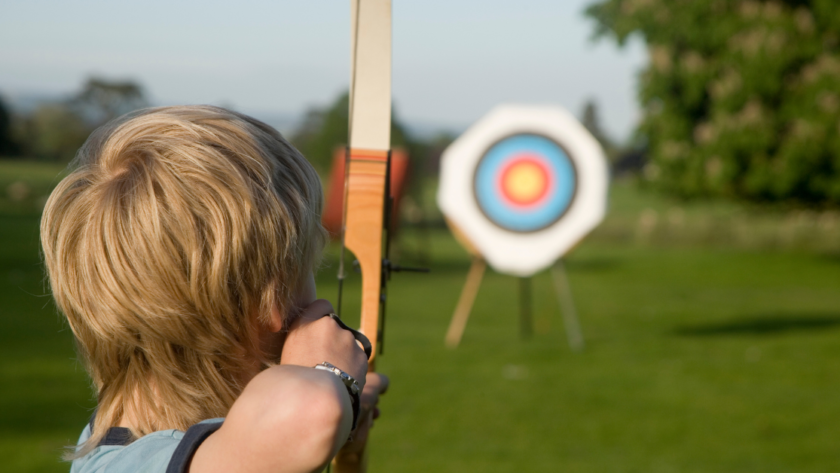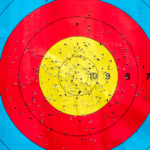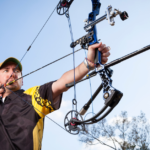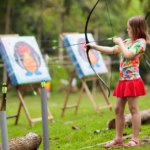This ancient art form combines physical skill, mental focus, and a deep connection to history. In this guide, I’ll share everything you need to know to start your archery journey on the right foot.
Choosing Your First Bow
The bow you select will significantly impact your early experiences in archery. Let’s explore the three main types of bows suitable for beginners:
Recurve Bows
Recurve bows are an excellent choice for newcomers to archery. Their distinctive curved limbs provide power and efficiency in a compact design.
Here’s why I often recommend recurve bows to my students:
- Forgiveness: Recurve bows are more tolerant of minor form mistakes, allowing beginners to focus on developing proper technique.
- Affordability: Generally less expensive than compound bows, recurve bows offer a cost-effective entry point into the sport.
- Versatility: Recurve bows provide a solid foundation for various archery disciplines, including target archery and traditional archery.
When selecting a recurve bow, pay close attention to the draw weight. For adult beginners, I suggest starting with a draw weight between 20-25 pounds.
This range allows you to develop proper form without excessive strain.
Compound Bows
Compound bows use a system of pulleys and cables to create a mechanical advantage. While popular in hunting and some competitive disciplines, I typically don’t recommend compound bows for absolute beginners.
Here’s why:
- Complexity: Compound bows need more maintenance and have more moving parts than recurve bows.
- Cost: They tend to be more expensive than recurve bows, which can be a significant investment for someone just starting out.
- Masking Form Issues: The let-off (reduction in holding weight at full draw) can hide problems with an archer’s form, potentially leading to bad habits.
However, if you’re specifically interested in bowhunting or certain competitive styles, a compound bow might be the right choice for you.
Traditional Longbows
Longbows offer a direct connection to archery’s historical roots. Their simple design belies the challenge they present to archers.
While I love the aesthetic and feel of a longbow, I typically suggest that beginners start with recurve bows.
Longbows can be an excellent option to explore as you advance in skill and want to experience a different aspect of archery.
Essential Archery Equipment
Beyond the bow itself, you’ll need several key pieces of equipment to get started in archery:
Arrows
Selecting the right arrows is crucial for your success and safety. Choose arrows that match your draw length and the bow’s draw weight.
For beginners, I recommend aluminum arrows.
They’re durable, cost-effective, and forgiving.
Arm Guard
An arm guard protects your forearm from the bowstring. Trust me, you’ll appreciate this piece of equipment after experiencing your first string slap!
Look for an arm guard that’s comfortable and provides adequate coverage for your forearm.
Finger Tab or Shooting Glove
These protect your fingers from the bowstring and confirm a clean release. A finger tab is typically used in target archery, while a shooting glove is more common in traditional archery.
Try both to see which feels more comfortable for you.
Target
Start with a large, foam target designed for beginners. As your skills improve, you can move on to smaller targets or 3D animal targets for variety.
Ensure your target is suitable for your bow’s draw weight to prevent arrow pass-throughs.
Quiver
A quiver holds your arrows safely when not in use. Hip quivers are popular for target archery, while back quivers are often used in traditional archery.
Choose a quiver that’s comfortable and easily accessible during your shooting sessions.
Mastering Proper Form and Technique
Consistency is the key to success in archery, and that starts with proper form. Let’s break down the basic shot process step by step:
1. Stance
Stand perpendicular to the target with your feet shoulder-width apart. Your body should form a T-shape with the shooting line.
This stable stance provides a solid foundation for your shot.
2. Nocking the Arrow
Place the arrow on the rest and clip the nock onto the string at the nocking point. Ensure the odd-colored fletching (if present) faces away from the bow.
3. Grip
Hold the bow with a relaxed hand, allowing it to rest in the web between your thumb and index finger. Avoid gripping the bow tightly, as this can introduce torque and affect accuracy.
4. Drawing
Raise the bow and draw the string back to your anchor point. For most archers, this is either the corner of the mouth or the chin. Use your back muscles to draw the bow, not just your arm.
5. Anchoring
Consistently place your drawing hand against the same point on your face for each shot. This anchor point serves as a reference for aiming and ensures consistency in your draw length.
6. Aiming
If your bow has a sight, align it with the target. For traditional archery, focus on the target itself (instinctive shooting).
Maintain a steady aim throughout the shot process.
7. Release
Smoothly relax your fingers to release the string. Avoid plucking or jerking the string, as this can introduce inconsistencies in your shot.
8. Follow-through
Maintain your position until the arrow hits the target. This helps with consistency and accuracy, and allows you to analyze your form after each shot.
Common Beginner Mistakes and How to Avoid Them
As you start your archery journey, be aware of these common pitfalls:
Gripping the Bow Too Tightly
A death grip on the bow can torque it upon release, affecting accuracy. Instead, use a relaxed grip and let the bow push into your hand upon release.
Many archers use a bow sling to prevent the bow from falling after the shot.
Inconsistent Anchor Point
Varying your anchor point changes the arrow’s trajectory. Choose one anchor point and stick with it for every shot.
This consistency is crucial for developing accuracy.
Peeking
Dropping your bow arm or turning your head to watch the arrow immediately after release can ruin your shot. Maintain your form through the entire shot process, including after the release.
Overdrawing
Drawing the bow beyond your comfortable anchor point can lead to poor form and even injury. Work with your natural draw length, which is typically your arm span divided by 2.5.
Neglecting Safety
Always inspect your equipment before shooting and be aware of your surroundings. Never shoot a bow without an arrow (dry firing), as this can damage the bow.
Safety should always be your top priority in archery.
Developing an Effective Practice Routine
Consistent practice is essential for improving your archery skills. Here’s a simple routine to get you started:
Warm-up (5-10 minutes)
Begin with light stretching, focusing on your shoulders, arms, and back. This prepares your muscles for the repetitive motions of archery and helps prevent injury.
Form Practice (15-20 minutes)
Start with blank bale shooting (shooting at a target with no aiming point). This allows you to focus on your form without the pressure of hitting a specific target.
Pay attention to each step of your shot process.
Aiming Practice (20-30 minutes)
Move on to shooting at a target, starting close and gradually increasing distance as you improve. Focus on consistency in your form while introducing the element of aiming.
Variation (10-15 minutes)
Introduce different types of targets or shooting scenarios to keep your practice interesting and challenging. This could include shooting at different distances, using 3D targets, or practicing under varying weather conditions.
Cool-down (5-10 minutes)
End with some light stretching to prevent soreness and maintain flexibility.
Remember, quality practice is more important than quantity. It’s better to shoot 20 arrows with perfect form than 100 with poor technique.
Listen to your body and avoid overtraining, especially when you’re just starting out.
Advanced Techniques: Taking Your Archery to the Next Level
As you become more comfortable with the fundamentals, consider exploring these areas to elevate your archery skills:
Mental Game
Archery is as much a mental sport as a physical one. Developing a strong mental game can significantly improve your performance.
Try these techniques:
- Visualization: Before shooting, visualize the perfect shot in your mind.
Imagine every detail, from your stance to the arrow hitting the bullseye.
- Breathing exercises: Controlled breathing can help manage nerves and improve focus.
Practice deep, rhythmic breathing during your shot sequence.
- Positive self-talk: Replace negative thoughts with positive affirmations.
Instead of worrying about missing, focus on executing your shot process correctly.
- Routine development: Establish a pre-shot routine to help you get into the right mindset for each arrow.
Equipment Tuning
Learning to tune your equipment can significantly improve your accuracy and consistency. Here are some basic tuning techniques:
- Nocking point adjustment: Ensure your nocking point is set at the fix height for optimal arrow flight.
- Center shot alignment: Adjust your arrow rest so the arrow is perfectly aligned with the string when at full draw.
- Bow weight adjustment: Fine-tune your bow’s draw weight to match your strength and shooting style.
- Arrow spine selection: Choose arrows with the fix spine (stiffness) for your bow and draw length.
Exploring Different Disciplines
Trying various archery disciplines can broaden your skills and keep your interest piqued. Consider exploring:
- Field Archery: Shoot at targets of varying distances in outdoor settings, often in wooded areas.
- 3D Archery: Practice your skills on three-dimensional animal targets, simulating hunting scenarios.
- Traditional Archery: Experience archery in it’s most basic form, using traditional bows without modern sights or stabilizers.
- Indoor Target Archery: Compete in a controlled environment, focusing on precision and consistency.
Strength Training for Archers
Developing specific muscle groups can significantly improve your archery performance. Focus on exercises that target:
- Back muscles: Rows, pull-ups, and lat pull-downs strengthen the muscles used in drawing the bow.
- Core strength: Planks, Russian twists, and other core exercises improve stability and posture.
- Shoulder stability: Rotator cuff exercises help prevent injury and improve control.
- Forearm and grip strength: Wrist curls and grip exercises enhance your ability to hold the bow steady.
Competitive Archery
Participating in local tournaments can be an excellent way to test your skills and meet other archers. Here’s how to get started:
- Join a local archery club: Many clubs host regular competitions and can provide guidance on tournament etiquette.
- Start with beginner-friendly events: Look for local 3D shoots or indoor leagues that welcome newcomers.
- Learn the rules: Familiarize yourself with the specific rules and scoring systems for your chosen discipline.
- Practice under pressure: Simulate competition conditions during your practice sessions to prepare for tournament nerves.
The Path to Archery Mastery
Archery offers endless opportunities for growth, both as an athlete and as an person. As you progress, you’ll find out about new challenges and rewards that keep the sport exciting and engaging.
Remember that every expert archer was once a beginner. With dedication, consistent practice, and a willingness to learn, you can achieve remarkable things in archery.
Embrace the process, enjoy the journey, and always strive to improve your skills.
Frequently Asked Questions
What is the best bow for a beginner archer?
For most beginners, a recurve bow with a draw weight between 20-25 pounds is an excellent starting point. Recurve bows are forgiving, affordable, and provide a solid foundation for learning proper technique.
How often should I practice archery as a beginner?
Aim for 2-3 practice sessions per week, each lasting about an hour. Consistency is more important than long, infrequent sessions.
Remember to focus on quality over quantity in your practice.
What safety precautions should I take when practicing archery?
Always inspect your equipment before use, never dry fire your bow, use an suitable backstop, and be aware of your surroundings. Wear an arm guard and follow all range rules when shooting at a facility.
How long does it take to become proficient in archery?
The time it takes to become proficient varies for each person. With consistent practice, most beginners can develop good form and accuracy within 3-6 months.
Mastery, however, is a lifelong pursuit.
Can I practice archery at home?
Yes, you can practice archery at home if you have a safe, suitable space. Ensure you have a proper backstop, adequate distance, and check local laws regarding backyard archery practice.
What muscles does archery work out?
Archery primarily works the muscles in your upper back, shoulders, arms, and core. Regular practice can improve strength and stability in these areas.
Is archery an expensive hobby to start?
The initial investment in equipment can be moderate, but archery doesn’t have to be expensive. Many beginners start with affordable recurve bows and basic accessories.
As you progress, you can invest in higher-quality equipment.
Can archery help improve mental focus?
Absolutely. Archery needs concentration, patience, and mental discipline.
Regular practice can help improve focus, reduce stress, and enhance overall mental well-being.
What’s the difference between Olympic archery and other forms?
Olympic archery uses recurve bows and follows specific rules and scoring systems. Other forms of archery include compound bow competitions, traditional archery, and various 3D and field archery disciplines.
How do I find archery clubs or lessons near me?
Check with local sporting goods stores, parks and recreation departments, or search online for archery clubs in your area. Many clubs offer beginner lessons and have equipment you can use to get started.
Key Takeaways
- Choose equipment that matches your goals and physical abilities
- Focus on developing proper form before worrying about accuracy
- Practice consistently, emphasizing quality over quantity
- Explore different aspects of archery to keep your interest and skills growing
- Embrace the mental aspects of the sport alongside the physical techniques



